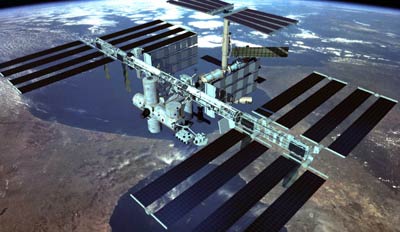Business on the ISS beyond space tourismby Taylor Dinerman
|
| Garriott will not only be Space Adventures’ sixth paying customer for a trip to the ISS but he will also be the first one to turn his flight into a business trip. |
Will this have an impact on the overall economics of the space station project? In an interview in the September 29th issue of Aviation Week, NASA Administrator Mike Griffin tries to address the criticism that “the research will never be worth the $100 billion invested in the space station.” His point is that most of that money has already been spent and that “It will exist. You can’t get the money back.” So now the question is how to make the ISS pay for itself.
Griffin points out that “you can’t schedule breakthroughs.” He is too careful to claim that there will be any major ones on the ISS, but there is a strong possibility that the Protein Crystal Growth (PCG) project will lead to a series of new medicines and medical treatments that could be worth tens of billions over time. The people whose lives are saved or simply made more productive by this process will make their own contributions to the world’s economy. From this exceedingly broad perspective, the ISS may, in fact, pay for itself—or even more.
It may be argued that the money would have been better spent on direct medical research, but of course that misses that point that PCG is just the first of many microgravity manufacturing possibilities. By learning how to do it in a small package and, more importantly, going through the process of getting the package certified as safe to fly by all the members of the ISS partnership, Garriott has opened the door to a long-term business.
The PCG package that will fly with him is almost certainly going to be the first of many. Thousands of PCG strands will be grown on the ISS and returned to Earth. Biologists and other scientists both at universities and in the commercial sector will find they have a whole new method of analyzing organisms. It is impossible to know precisely how this new set of tools will pay off, but it’s hard to imagine circumstances where it altogether fails to expand humanity’s basic knowledge of ourselves and our world.
A decade ago, when the ISS was just beginning to be built, a few congressmen who had supported the package were already complaining that NASA had sold them a bill of goods. According to them, NASA had claimed that the ISS would produce a cure for cancer and other medical breakthroughs. Space exploration has always led to improvements in treatments for the frail human body, but that is not a good reason to support the program.
Ever since the Vision for Space Exploration (VSE) was launched in January 2004, many scientists and other experts have complained that the US budget for science onboard the ISS had been more or less eliminated in favor of research work intended to support the VSE. Luck would have it that the private sector, in the persons of Richard Garriott and Tom Pickens of SPACEHAB, who already flew a biological research package on STS-124 in June of this year, have taken up the challenge. This is a fine example of the law of supply and demand at work in outer space.
| The ISS may yet fulfill all of the promises that NASA’s managers so recklessly made, so long ago. |
In 2005, the US Congress ordered NASA to designate the US segment of the ISS as a national laboratory, thus opening it up to use by other government agencies and by commercial and other entities. It will take a few years before we see any results, but already the space agency has signed agreements with SPACEHAB, Zero G Corporation, and the University of Colorado at Boulder; there will likely be others. The process, like most things in the space business, has been agonizingly slow. The payoff could be gigantic in ways we can only begin to imagine.
In the late 1970s and early 1980s when the Navstar/GPS system was being designed and built, few if any experts imagined that it would become a critical part of the world’s infrastructure. When the ISS program began in the mid-1980s NASA, unlike the Pentagon, made all sorts of promises about its potential, but so far few of these have come to pass. Yet in spite of everything the ISS is still an amazing place in space. Now that it is on the verge of completion, the process of getting the maximum return on investment has begun.
The opportunity is up there. It would be unrealistic to think that no one will be able to take advantage of what is being offered. The ISS may yet fulfill all of the promises that NASA’s managers so recklessly made, so long ago.
